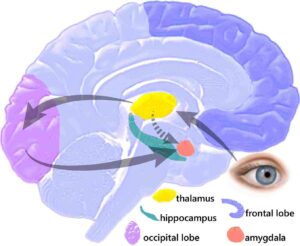Amygdala Hyperactivity Disorder (AHD) is caused by an overactive amygdala, the section of the brain responsible for fear and emotions. Symptoms of AHD include recurring panic attacks, difficulty concentrating and sleeping, as well as feelings of dread or apprehension in certain situations. With the right treatment approach, however, it is possible to calm down an overactive amygdala and live happily without crippling anxiety! In this blog post, we will explore overactive amygdala treatment options and some benefits. We will also discuss the expected cost and duration of the treatment.
Contents
What Is An Overactive Amygdala?
 The amygdala is a part of our brain that plays a crucial role in regulating our emotions. When our amygdala becomes overactive, it can cause us to feel intense emotions like fear, anxiety, and anger more easily and frequently than normal.
The amygdala is a part of our brain that plays a crucial role in regulating our emotions. When our amygdala becomes overactive, it can cause us to feel intense emotions like fear, anxiety, and anger more easily and frequently than normal.
This can lead to a range of issues such as difficulty controlling our emotions, increased stress levels, and trouble sleeping. It’s important to note that an overactive amygdala is often a symptom of an underlying condition like anxiety disorder, and seeking professional help can be beneficial in managing and treating these symptoms.
Can Overactive Amygdala Be Cured?
While there is no specific cure for an overactive amygdala, there are several ways to manage its symptoms. Overactive Amygdala Treatment involving Therapy techniques can be effective in reducing anxiety and fear responses. Medications like antidepressants and anti-anxiety medications can also help manage symptoms, but they may not work for everyone. Lifestyle changes like regular exercise, healthy eating, and stress management techniques like meditation and deep breathing can also be helpful. It’s important to work with a mental health professional to find the best treatment plan for your individual needs.
Therapy Treatment For Overactive Amygdala
Here are some points on therapy treatments for an overactive amygdala:
Cognitive-behavioral therapy (CBT)
Cognitive-behavioral therapy (CBT) is a type of therapy that can be effective for people with an overactive amygdala. It focuses on identifying and changing negative thought patterns and behaviors that contribute to anxiety and fear responses. CBT can help develop coping skills and techniques to manage emotions effectively.
Exposure therapy
Exposure therapy is a type of therapy that gradually exposes people to the things or situations that trigger their anxiety or fear. It can be helpful for people with an overactive amygdala by helping to reduce the intensity of emotional responses and develop resilience. Exposure therapy is typically done in a controlled and supportive environment.
Mindfulness-based therapies
 Mindfulness-based therapies can be effective for people with an overactive amygdala. These therapies help individuals develop greater awareness and acceptance of their thoughts and emotions. By learning to observe and regulate their responses, people can develop effective strategies for managing their anxiety and fear. Mindfulness-based therapies include techniques like meditation, deep breathing, and body awareness exercises.
Mindfulness-based therapies can be effective for people with an overactive amygdala. These therapies help individuals develop greater awareness and acceptance of their thoughts and emotions. By learning to observe and regulate their responses, people can develop effective strategies for managing their anxiety and fear. Mindfulness-based therapies include techniques like meditation, deep breathing, and body awareness exercises.
EMDR treatment
Eye Movement Desensitization and Reprocessing (EMDR) is a type of therapy that can be helpful for people with an overactive amygdala who have experienced traumatic events. It uses eye movements to help process traumatic memories and reduce the emotional intensity of the associated triggers. EMDR can help individuals develop greater resilience and reduce the impact of past trauma on their current emotional state.
Group therapy
Group therapy can be a helpful treatment for people with an overactive amygdala. It provides a safe and supportive environment for individuals to share their experiences and learn from others who may be going through similar struggles. Group therapy can also help build social support and reduce feelings of isolation.
Medications For Overactive Amygdala
Here are some points on medications for an overactive amygdala:
Antidepressants
These medications can be effective in managing anxiety and fear responses. Selective serotonin reuptake inhibitors (SSRIs) are commonly prescribed antidepressants that work by increasing levels of serotonin, a neurotransmitter that regulates mood and emotions.
Anti-anxiety medications
These medications can help reduce anxiety symptoms, such as feelings of panic and fear. Benzodiazepines are a type of anti-anxiety medication that works by enhancing the effects of a neurotransmitter called gamma-aminobutyric acid (GABA), which helps regulate anxiety.
Beta-blockers

Beta-blockers are a type of medication that can be helpful for people with an overactive amygdala. They work by blocking the effects of adrenaline, a hormone that triggers the body’s “fight or flight” response. This can help reduce physical symptoms of anxiety, such as rapid heart rate and trembling. Beta-blockers are typically used in combination with therapy and lifestyle changes for the best outcomes.
Atypical antipsychotics
These medications are sometimes used to manage severe anxiety symptoms or as an adjunct treatment with antidepressants. They work by modulating the levels of neurotransmitters such as dopamine and serotonin in the brain.
Finding The Best Overactive Amygdala Treatment
Given below are some ways through which you can find a treatment for Overactive Amygdala:
- Search online: Find information on treatment options for an overactive amygdala on websites and online directories. Make sure to look for reviews, locations, fees, and schedule of the therapist.
- Referrals: Ask your primary care physician or mental health professional. They may be able to refer a specialist or treatment center that specializes in treating an overactive amygdala.
- Recommendations: Ask your friends, family members, or support groups who have experience managing an overactive amygdala. They may be able to provide valuable insights and advice.
- Insurance Provider: Check with your insurance provider to see what treatment options are covered under your plan. This can help you find a treatment that is both effective and affordable.
Benefits Of Treatment
Here are some benefits of treatment for an overactive amygdala:
- Reduced anxiety and fear: Treatment can help individuals develop coping skills and strategies to manage their emotions effectively, resulting in reduced anxiety and fear responses.
- Improved quality of life: By reducing the impact of an overactive amygdala on daily life, treatment can improve the overall quality of life and promote a sense of well-being.
- Better relationships: Treatment can help individuals build social support and reduce feelings of isolation, leading to improved relationships with others.
- Improved physical health: Chronic anxiety and fear can have negative effects on physical health, so reducing these symptoms through treatment can help promote overall physical health.
- Increased resilience: Treatment can help individuals develop greater resilience and the ability to cope with difficult situations and emotions healthily.
- Improved work or school performance: By reducing the impact of anxiety and fear on daily life, treatment can improve performance in work or school settings.
Expected Cost And Duration For Recovery
The cost and duration of recovery for an overactive amygdala can vary depending on the severity of symptoms, the type of treatment, and other individual factors. Therapy can range from a few weeks to several months or more and can cost anywhere from a few hundred to several thousand dollars depending on the frequency and length of sessions. Medications can also be costly and require ongoing monitoring by a healthcare provider. It’s important to work with a healthcare provider to determine the best treatment options and to discuss any potential costs or insurance coverage.
Conclusion
In conclusion, an overactive amygdala can cause a range of symptoms, including anxiety, fear, and other emotional disturbances. However, there are several effective treatments available, including therapy, medication, and mindfulness-based techniques. Treatment can help individuals reduce anxiety and fear, improve their quality of life, and build resilience. It’s important to work with a healthcare provider to determine the best treatment plan for individual needs and to discuss any potential costs or insurance coverage. With the right treatment and support, individuals with an overactive amygdala can manage their symptoms and live healthy, fulfilling lives.
For more information, please contact MantraCare. Anxiety is a common mental health condition characterized by persistent feelings of worry, fear, and apprehension. If you have any queries regarding Online Anxiety Counseling experienced therapists at MantraCare can help: Book a trial Anxiety therapy session.


